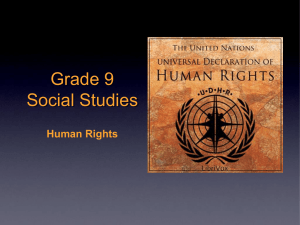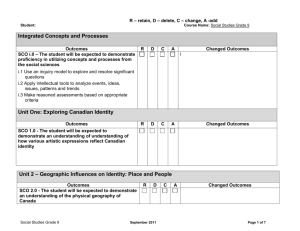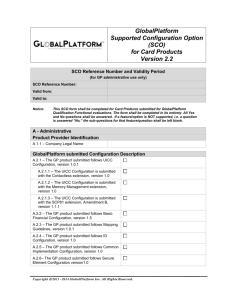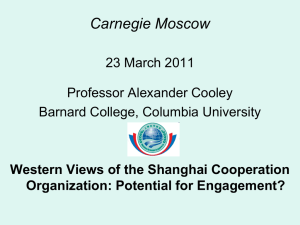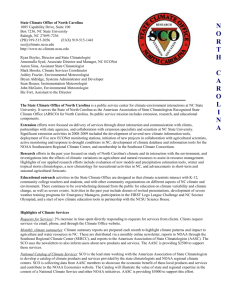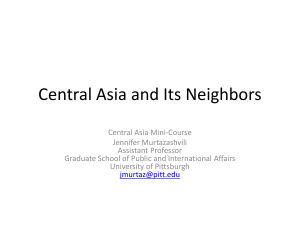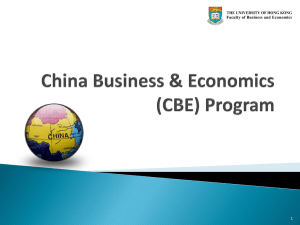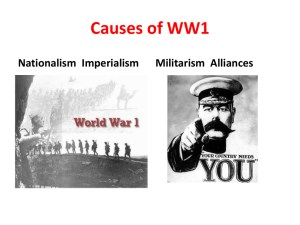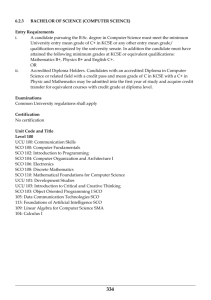Prezentace aplikace PowerPoint
advertisement
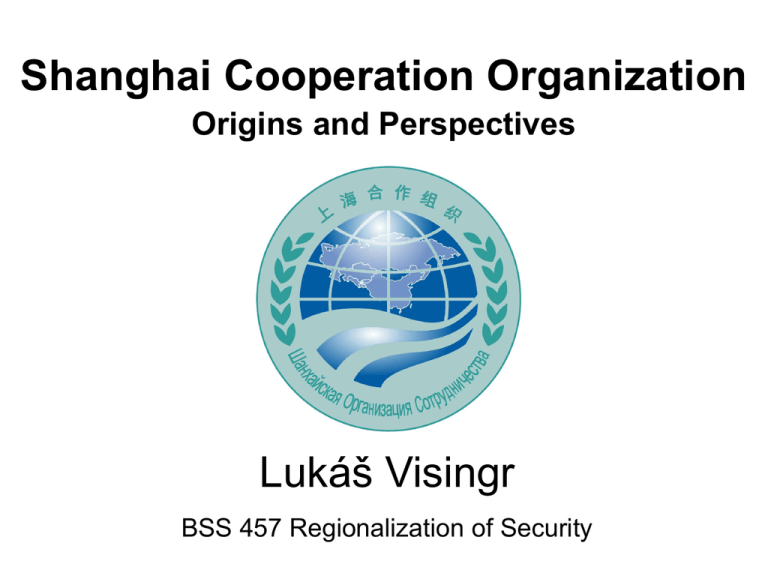
Shanghai Cooperation Organization Origins and Perspectives Lukáš Visingr BSS 457 Regionalization of Security Contents 1. History 2. Membership 3. Structure 4. Activities 5. SWOT analysis 6. Conclusions Russian: Шанхайская организация сотрудничества Chinese: 上海合作 (Shanghai Hezuo Zuzhi) 1. History • 1996: Treaty on Deepening Military Trust in Border Regions, socalled „Shanghai Five“ (RF, PRC, Kaz., Kyr., Taj.) • 1997: Treaty on Reduction of Military Forces in Border Regions • 2001: Shanghai Cooperation Organization (with Uzb.), Treaty of Good-Neighbourliness and Friendly Cooperation (RF, PRC) • 2002: Shanghai Cooperation Organization Charter • 2003: proposal of free-trade area (by PRC) • 2004: Regional Anti-Terrorist Structure • 2005: USA urged to set a timetable for withdrawing their forces from SCO members, observer status refused • 2007: agreement with CSTO to broaden cooperation 2. Membership 6 regular members: • Russia • China • Kazakhstan • Tajikistan • Uzbekistan • Kyrgyzstan 4 observers: • India • Pakistan • Iran • Mongolia 2. Membership • • • • 6 members: Russia, China, Kazakhstan, Tajikistan, Uzbekistan, Kyrgyzstan 4 observers: India, Pakistan, Iran, Mongolia 2 dialogue partners: Belorussia, Sri Lanka 3 guest attendances: Afghanistan, ASEAN, CIS 2. Membership Collective Security Treaty Organization Russia Belorussia Armenia Kazakhstan Tajikistan Uzbekistan Kyrgyzstan 3. Structure • The Council of Heads of State (annual summits in capitals) • The Council of Heads of Government (annual summits) • The Council of Foreign Ministers (regular meetings) • The Council of National Coordinators (multilateral cooperation) • The Secretariat of the SCO (primary executive organ) • The Regional Anti-Terrorist Structure (permanent organ) • Non-governmental institutions: SCO Business Council, SCO Interbank Consortium, SCO Forum 3. Structure 4. Activities SECURITY COOPERATION: • Shift from border security issues to broader cooperation in stabilizing the Central Asia • The official goal is to counter „three evils“ of terrorism, separatism and extremism • Although the SCO declares no intentions to become a military bloc, full-scale involvement of military forces is seen as a necessary tool • Joint military exercises; however, the Russian-Chinese Peace Mission exercises are held outside of the SCO 4. Activities ECONOMIC COOPERATION: • Trade: Chinese proposal of free-trade area • Finances: Interbank Consortium, actions against global financial crisis (Chinese loans) • Energy: joint resources projects (oil, gas, water) CULTURAL COOPERATION: • Arts, festivals, exhibitions… (mainly symbolic) 5. SWOT analysis 5. SWOT analysis STRENGTHS: • Gigantic potential: area over 30 million km2, population over 1,5 milliard people, GDP almost 10 billion USD • Enormous natural resources of Russia and Central Asia • Strong national economy of China • Powerful military forces of Russia and China 5. SWOT analysis WEAKNESSES: • Structural fragility: three states strong (RF, PRC, Kaz.) and three significantly weaker (Kyr., Taj., Uzb.) • Very different (and in some issues, rather contradictory) motivations of two main actors (RF, PRC) and yet very different view of the other four members • Tensions between members and observers (RF×PRC, PRC×Kaz., PRC×India, India×Pakistan…), still unclear sense of the observer status itself • Tensions between resource-suppliers and consumers • No clause of mutual / collective defense (×CSTO) • No common „identity“ or „values“, lack of „soft power“ 5. SWOT analysis OPPORTUNITIES: • Stabilization and utilization of Central Asia • Expansion to South Asia and Middle East • Suppression of Islamic extremism and terrorism • Challenging the global dominant position of the USA and NATO (forming an „Eastern NATO“?) • Forming a strong independent economic block 5. SWOT analysis THREATS: • Islamic extremism and terrorism and various forms of separatism (mutual support disputable) • Strength of the USA and the whole West: Washington could launch a new „diplomatic offensive“ to „get back“ the Central Asian states • Global economic crisis: growing problems of Russia, possible collapse of China 6. Conclusions • SCO has established as a potentially important security actor in Central Asia and it provides (at least discussion) platform for security cooperation • However, it has got fundamental weaknesses, above all the relations between Russia and China • Security cooperation can improve, but closer military ties would probably collide with CSTO and deeper economic integration seems hardly imaginable • The real „menace“ to the West is nothing but symbolic • Not „Eastern NATO“, rather „Eastern OSCE“, but without comparable legitimacy; OSCE is at least respected as an „arbiter“, while SCO is rather a „power tool“ Main sources • Cohen, A.: Competition over Eurasia: Are the U.S. and Russia on a Collision Course?, on-line text (http://www.heritage.org/Research/RussiaandEurasia/hl901.cfm). • Cohen, A.: The Russia-China Friendship and Cooperation Treaty: A Strategic Shift in Eurasia?, on-line text (http://www.heritage.org/Research/RussiaandEurasia/BG1459.cfm). • Horák, S.: Rusko a Střední Asie po rozpadu SSSR, Praha: Univerzita Karlova – Nakladatelství Karolinum 2008. • Shanghai Cooperation Organization, WWW site (http://www.sectsco.org/). • Sznajder, A. P.: China’s Shanghai Cooperation Organisation Strategy, online text (http://irps.ucsd.edu/assets/004/5367.pdf). • Weitz, R.: SCO fails to solve its expansion dilemma, on-line text (http://www.cacianalyst.org/?q=node/4697).
